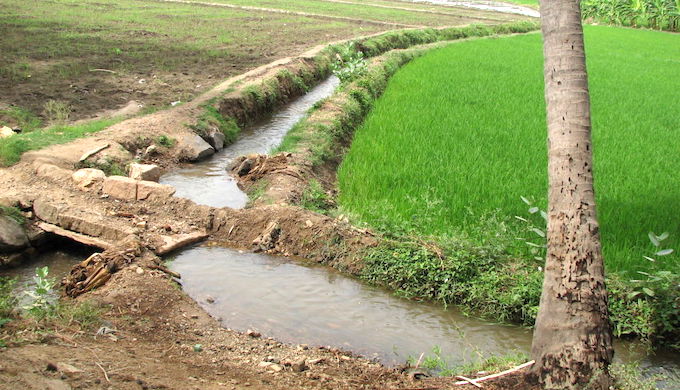Anurag Verma is a rich and curious farmer. His gently waving fields of wheat are ready to ripen, but he is wondering why he has to dig over 200 ft to water them, when he is barely 2 km from the Yamuna River.

As you drive just around 10 km out of Delhi towards Chandigarh, you can see one edge of Anurag’s 24-hectare farm from the highway. And if you take the right turn, you can soon see water gushing through irrigation channels.
Does he need to flood his wheat farm with that much water? No, Anurag replies. In fact, the plants would rot if the water were not drained out after a while. So he has channels going out of his farm to the drain, he explains.
Anurag could surely afford to lay pipes where his irrigation channels are, and to use drip irrigation. Has he ever thought of it? Yes, but what’s the point, he responds. Every other farmer around will still pump up water for flood irrigation, and the water table will keep going down, irrespective of what he does alone.
Tragedy of commons
This classic tragedy of the commons bedevils groundwater all over India. No one conserves water because everyone feels if he does so, the neighbours will simply take a larger share. In the absence of any law regulating groundwater extraction, India has become the world’s largest user, mainly for agriculture. The larger the farm, the more the water wasted, the more wells dry out nearby, the more suffering for the poor who cannot afford to dig deep.
It goes directly against the idea of “leaving no one behind” – this year’s theme on World Water Day, March 22. But given the powerful farmers’ vote bank, not a single politician is talking about regulating groundwater use as they campaign for India’s general elections scheduled over seven phases in April and May.
But as large parts of peninsular India and Gujarat stare at drought this year, the politicians cannot help talking about water. Candidates are going around promising more and deeper wells if they are elected. None seems to care about the dropping water table, especially below the hard rocks of peninsular India, where it takes thousands of years for water to percolate underground.
Anurag Verma is fortunate that his farm is in the relatively alluvial Indo-Gangetic plains, with its perennial rivers and easier percolation underground. Even there, the drop is serious, and worsened by water-hungry crops such as sugarcane and rice in areas where nature did not intend them to be grown.
Disastrous drop
When it comes to the Deccan Plateau, the drop in the water table is disastrous, and it is worsened by far in just the same way – by growing sugarcane and with equally water-hungry vineyards coming up by the dozen. Maharashtra regularly comes up with new brands of wine, much beloved by the country’s chattering classes who neither know nor care about how much water the grapes drink and what it does to the poor people who have to depend on the wells around the vineyards.
In India, the law says if you own a piece of land, you may dig below it as deep as you can, install a pump, and pull up an unlimited amount of water. Add to this the fact that farmers do not have to pay for electricity. No political party is even thinking of confronting these two elephants in the room. When leaders are asked, they mutter about the farmers’ vote bank and shrug helplessly.
The solution thought up by some policymakers and embraced by the ruling Bharatiya Janata Party – among others – is a mega-disaster in the making. This is the interlinking of rivers grand plan, which has already started in various parts of the country. Ignoring basic hydrology, this is a plan to transfer water from one river basin to another, culminating in the mega transfer of water from the Brahmaputra basin in north-eastern India to western India.
Construction dreams
Through pumping, it plans to get over the basic nature of water to flow downwards. It pays almost no attention to the future of basins from which the water will be taken away, or to the areas on the way. The plan is a golden dream for construction firms and a nightmare for everyone else. But the outgoing government is determined to go ahead with it if it comes back to power.
The meteorology of South Asia dictates prudent water use and water conservation – most of the rainfall is between June and September, and the subcontinent has to live with that for the whole year. It has done so for thousands of years through highly sophisticated water harvesting systems that change from place to place depending on rainfall, temperature and soil type – from ponds to wells to stepwells to minimise evaporation to underground stores below sand dunes that were locked against theft to ensuring tree cover at the top of every hill stream to maximise percolation and keep the springs alive.
The arrogance brought by modern technology in the last two centuries has disrupted these systems almost everywhere. But they are by no means lost; they will have to be mainstreamed and modern technology will have to be used for them instead of the other way around if India is to have enough water for survival.
Courtesy: Counter View
